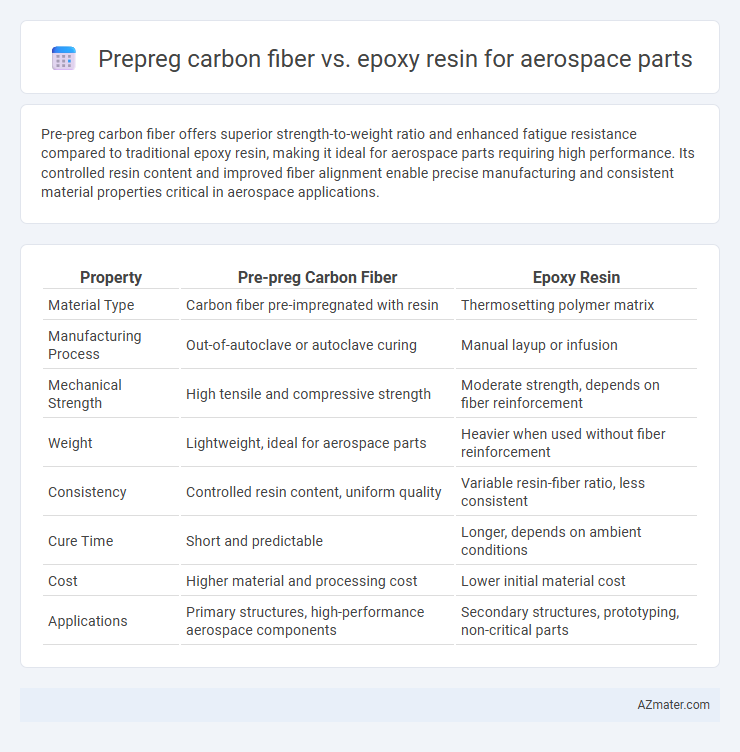Pre-preg carbon fiber offers superior strength-to-weight ratio and enhanced fatigue resistance compared to traditional epoxy resin, making it ideal for aerospace parts requiring high performance. Its controlled resin content and improved fiber alignment enable precise manufacturing and consistent material properties critical in aerospace applications.
Table of Comparison
| Property | Pre-preg Carbon Fiber | Epoxy Resin |
|---|---|---|
| Material Type | Carbon fiber pre-impregnated with resin | Thermosetting polymer matrix |
| Manufacturing Process | Out-of-autoclave or autoclave curing | Manual layup or infusion |
| Mechanical Strength | High tensile and compressive strength | Moderate strength, depends on fiber reinforcement |
| Weight | Lightweight, ideal for aerospace parts | Heavier when used without fiber reinforcement |
| Consistency | Controlled resin content, uniform quality | Variable resin-fiber ratio, less consistent |
| Cure Time | Short and predictable | Longer, depends on ambient conditions |
| Cost | Higher material and processing cost | Lower initial material cost |
| Applications | Primary structures, high-performance aerospace components | Secondary structures, prototyping, non-critical parts |
Introduction to Aerospace Composite Materials
Pre-preg carbon fiber offers superior strength-to-weight ratio and consistent resin distribution compared to traditional epoxy resin, making it ideal for high-performance aerospace components requiring precision and durability. Aerospace composite materials leverage the advanced mechanical properties of pre-impregnated fibers cured under controlled conditions to enhance fatigue resistance and structural integrity. This combination supports the industry's demand for lightweight, high-strength parts that improve fuel efficiency and overall aircraft performance.
Overview of Pre-preg Carbon Fiber
Pre-preg carbon fiber consists of carbon fibers pre-impregnated with a precise amount of epoxy resin, ensuring consistent resin distribution and optimal fiber-to-resin ratio crucial for aerospace applications. This material offers superior mechanical properties, enhanced strength-to-weight ratio, and excellent thermal stability, making it ideal for high-performance aerospace components. The controlled curing process of pre-pregs allows for higher quality parts with reduced void content and improved structural integrity compared to traditional wet layup epoxy resin methods.
Properties of Epoxy Resin in Aerospace
Epoxy resin in aerospace applications offers exceptional mechanical strength, superior adhesion to carbon fiber, and excellent chemical resistance, making it ideal for high-performance components. Its low viscosity allows for optimal fiber impregnation, resulting in enhanced composite durability and reduced weight critical for aerospace efficiency. The thermal stability and resistance to environmental degradation of epoxy resin ensure long-term reliability of aerospace parts under extreme conditions.
Manufacturing Processes: Pre-preg vs Epoxy Resin
Pre-preg carbon fiber composites offer superior consistency and control in aerospace manufacturing due to their pre-impregnated resin content and partially cured state, enabling precise layup and reduced void content during autoclave curing. Epoxy resin systems require on-site resin infusion or hand layup, increasing variability and potential for defects like resin-rich areas or dry spots, impacting mechanical performance. The controlled curing environment for pre-pregs results in enhanced fiber-resin bonding and repeatable aerospace-quality parts, while epoxy resin composites may demand additional process optimization to achieve similar standards.
Mechanical Strength and Durability Comparison
Pre-preg carbon fiber composites exhibit superior mechanical strength and enhanced durability compared to traditional epoxy resin matrices, making them ideal for aerospace applications requiring high stiffness-to-weight ratios. The pre-impregnated fibers ensure consistent resin distribution and optimal fiber alignment, resulting in improved tensile strength, impact resistance, and fatigue life. Aerospace parts manufactured with pre-preg carbon fiber typically demonstrate greater resistance to environmental degradation and stress-related failures than those using hand-laminated epoxy resin systems.
Weight Reduction and Performance Benefits
Pre-preg carbon fiber offers superior weight reduction compared to traditional epoxy resin systems due to its controlled fiber alignment and consistent resin content, resulting in higher strength-to-weight ratios essential for aerospace applications. The enhanced mechanical properties of pre-preg carbon fibers improve fatigue resistance and impact performance, enabling longer service life and increased safety margins in aerospace components. These performance benefits translate into more efficient fuel consumption and payload capacity, critical factors in aerospace engineering.
Cost Analysis: Pre-preg Versus Epoxy Resin
Pre-preg carbon fiber materials exhibit higher upfront costs compared to traditional epoxy resin due to the specialized manufacturing and storage requirements needed to maintain their quality. While epoxy resin presents a lower initial material cost, pre-preg offers reduced labor costs and enhanced performance that can lead to overall savings in aerospace part production. Life-cycle cost analysis indicates that pre-preg carbon fiber typically delivers improved durability, reduced rework rates, and better consistency, justifying its premium price in aerospace manufacturing.
Quality Control and Defect Rates
Pre-preg carbon fiber offers superior quality control in aerospace parts manufacturing due to its consistent resin content and uniform fiber distribution, significantly reducing defect rates compared to traditional epoxy resin hand layups. Automated curing processes for pre-pregs ensure precise temperature and pressure control, minimizing voids and delamination risks critical for aerospace structural integrity. Studies indicate pre-preg composites exhibit lower porosity and higher mechanical performance, meeting stringent aerospace certification standards with fewer quality deviations.
Applications in Aerospace Structures
Pre-preg carbon fiber offers superior strength-to-weight ratio, making it ideal for critical aerospace structures such as fuselage panels, wing skins, and control surfaces where weight reduction and durability are paramount. Epoxy resin systems, commonly used as the matrix in composite fabrication, provide excellent adhesion, thermal stability, and resistance to environmental factors, enhancing the performance and longevity of aerospace components. The combination of pre-preg carbon fiber with advanced epoxy resin creates high-performance composites that meet stringent aerospace standards for mechanical strength, fatigue resistance, and structural integrity.
Future Trends in Aerospace Composite Materials
Pre-preg carbon fiber offers superior strength-to-weight ratio and enhanced curing consistency compared to traditional epoxy resin, making it a preferred choice for advanced aerospace components. Future trends indicate the integration of nanomaterials and bio-based resins to improve environmental sustainability and mechanical performance in aerospace composites. Industry research is also focused on automated fiber placement and advanced curing technologies to optimize manufacturing efficiency and part reliability.

Infographic: Pre-preg carbon fiber vs Epoxy resin for Aerospace part
 azmater.com
azmater.com